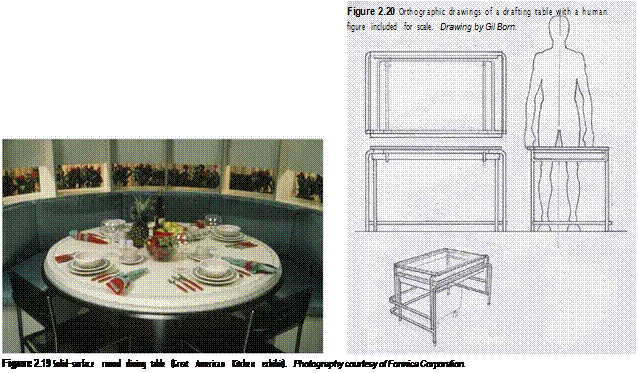and Writing
People depend on furniture to perform a variety of activities. Furniture influences how one experiences a meal, reads a book, types a report, works at a computer, or writes at a desk, though the relationships between the form, material, and activity need to be studied further. The ability to identify the measurable and material aspects of furniture that contribute to structural integrity, use, and pleasure is key to understanding basic relationships in design.
Eating, reading, typing, and writing are performance-based activities. Observing and analyzing correlations between furniture, the human body, and activities can help designers better understand how and why furniture performs well or poorly. Bureaus, desks, lecterns, tables, workbenches, and workstations are designed to accommodate many
Activities: Eating, Reading, Typing, and Writing 25
intended purposes and a broad range of users, which further complicate the parameters of design. Such furnishings are distinct from human body supports in that they primarily support activities rather than the human form.
Consider the activities involved in sharing a meal and reflect upon how a table’s form and shape, size, height, materials, structural stability, edge profile, weight, and spatial location can influence patterns of behavior and communication during a meal (Figure 2.19). An effective and sensitive design can assist the behaviors and contribute to the psychological and physiological experiences of dining.
Observe people reading and typing at a chair and table. Note how often posture changes during each activity. How often do people shift their posture in order to keep their blood moving and stay comfortable when sitting? Observe how chairs and tables support and compromise various activities. Consider sitting as a dynamic and ever-changing activity.
The height and depth of horizontal surfaces influence the utility of tables and counters. Designers may want to consider sketching or modeling a human figure when delineating horizontal surfaces (Figure 2.20). One needs to consider furniture relative to standing, leaning, and sitting as well as the various ways of working, resting, speaking, reading, typing, and reaching. Most contemporary societies have developed dimensional standards for specific activities. The following conventional standards apply to work surfaces and tables throughout many Western societies.4
■ Accessible counters and horizontal surfaces for wheelchair use are 30 inches (76.2 cm) high.
■ Kitchen counters range in height between 30 and 38 inches (76.2 and 95.7 cm) and are typically 24 inches (61 cm) deep.
■
 |
Standing bar surfaces are 42 inches (106.6 cm) high.
■ Reading tables are between 25 inches (63.5 cm) and 33 inches (83.8 cm) high, depending on clearance needs for youth, adults, and wheelchair users.
■ Dining tables and kitchen nooks are 29-30 inches (74-76.2 cm).
■ The size of a dining table is based on 24 inches (61 cm) of minimum space for the seated person and 8 inches (20.4 cm) of additional space on either side.
■ Lecterns and reading podiums should be adjustable between 42 inches (106.6 cm) and 48 inches (122 cm) in height.



